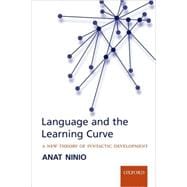
Note: Supplemental materials are not guaranteed with Rental or Used book purchases.
Purchase Benefits
Looking to rent a book? Rent Language and the Learning Curve A New Theory of Syntactic Development [ISBN: 9780199299829] for the semester, quarter, and short term or search our site for other textbooks by Ninio, Anat. Renting a textbook can save you up to 90% from the cost of buying.
| Acknowledgements | p. vi |
| Reader Quotations | p. xi |
| Introduction | p. 1 |
| Valency | p. 6 |
| Linguistic approaches to valency and syntactic structure | p. 7 |
| Implication for acquisition: syntax is simple | p. 16 |
| Developmental evidence: the earliest word combinations are syntactic mergers | p. 16 |
| Conclusions: children learn to merge two words according to their valency | p. 29 |
| Notes | p. 32 |
| The learning curve | p. 37 |
| The learning curve in cognitive psychology | p. 37 |
| Implication for acquisition: syntax should transfer right away | p. 44 |
| Developmental evidence: learning curves and generalizations in early syntax | p. 46 |
| Conclusions: lexical-specific syntactic frames facilitate others | p. 62 |
| Notes | p. 65 |
| Lexicalism | p. 69 |
| The linguistic basis to lexicalism | p. 70 |
| Implication for acquisition: no abstract schema formation | p. 77 |
| Developmental evidence: no change in the form of syntactic schemas | p. 78 |
| Conclusions: children learn a lexicalist syntax | p. 83 |
| Notes | p. 87 |
| Similarity | p. 90 |
| Similarity for transfer and generalization | p. 91 |
| Implication for acquisition: no role for semantic linking in learning syntax | p. 97 |
| Developmental evidence: no semantic effects in generalization and transfer | p. 101 |
| Conclusions: children utilize similarity of form to organize the process of acquisition | p. 114 |
| Notes | p. 115 |
| The growth of syntax | p. 119 |
| The language web | p. 119 |
| Implication for acquisition: learning means linking to the network | p. 126 |
| Developmental evidence: children recreate the global features of the maternal network | p. 130 |
| Conclusions: children join the language network | p. 141 |
| Notes | p. 146 |
| References | p. 151 |
| Author Index | p. 187 |
| Subject Index | p. 195 |
| Table of Contents provided by Ingram. All Rights Reserved. |
The New copy of this book will include any supplemental materials advertised. Please check the title of the book to determine if it should include any access cards, study guides, lab manuals, CDs, etc.
The Used, Rental and eBook copies of this book are not guaranteed to include any supplemental materials. Typically, only the book itself is included. This is true even if the title states it includes any access cards, study guides, lab manuals, CDs, etc.